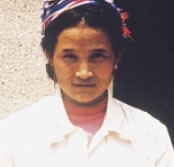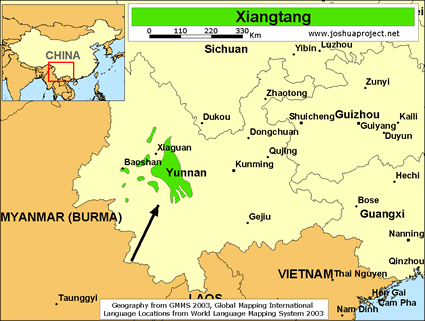The Chinese authorities have placed the Xiangtang under the official Yi nationality. Many Xiangtang in Simao have been thoroughly assimilated to Han Chinese culture and language. Only pockets of Xiangtang people living in more remote locations still retain their traditional way of life.
The Xiangtang are one of the southernmost Yi groups in China; this suggests that they may have been one of the earliest groups to migrate from the Yi homeland in today's Guizhou Province.
Since many Xiangtang have been gradually assimilated during the course of the twentieth century, most of their original customs have been lost. In the past, Xiangtang men had to pay a bride-price of five taels of silver to procure a wife. Alternatively, they could agree to work three years for the bride's family. In a Xiangtang home, guests of high status are seated behind the hearth, the host is seated on the right, and lower status people sit nearest the door. The main diet of the Xiangtang is maize, buckwheat, bean curd, pancakes, and sour and dried vegetables.
The Xiangtang believe in ancestor worship, mixed with animism. This remains the dominant religion among the Xiangtang, although many who live in urban areas have forsaken all religious practices. The Xiangtang living in Honghe are the only speakers of a Western Yi language in that prefecture. "While their language is widely different from the Yuanyang Nisu they live beside, the Xiangtang of Luchun County have been influenced by the Nisu culturally. Both groups worship and revere the dragon, but the Xiangtang also have reverence for the 'spirit of the ravine' whom they call to their aid every eighth day of the second lunar month."
The Xiangtang are one of many people groups in Yunnan Province with few or no known believers or Christian churches. It is possible that there are a few assimilated Xiangtang individuals attending Han Chinese churches. There are several thousand believers in the Jinghong and Mengla areas of Xishuangbanna Prefecture, but they are not known to be specifically focusing on unreached people groups for evangelism. The Xiangtang have been without a resident missionary or church-planting effort throughout their entire history.
The Xiangtang people need to put their trust and identity in the hands of the loving God of Creation who sent his son to make it possible for them to enter the Kingdom of God.
Pray for the spiritual blindness and bondage to the evil one to be removed so they can understand and respond to Christ.
Pray for the Lord to provide for their physical and spiritual needs as a testimony of his power and love.
Pray the Xiangtang people will have a spiritual hunger that will open their hearts to the King of kings.
Pray for an unstoppable movement to Christ among them.
Scripture Prayers for the Xiangtang in China.
Operation China, Asia Harvest, Copyrighted © Used with permission
| Profile Source: Joshua Project |











